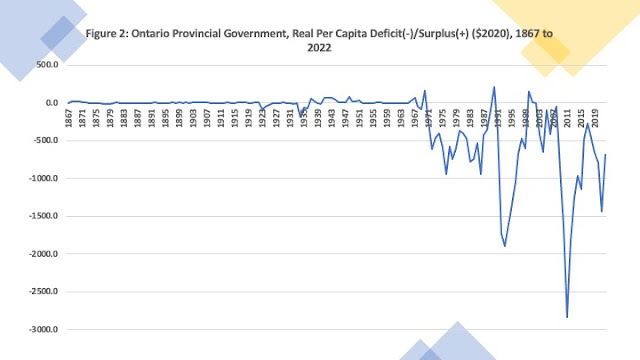The last week has been a chaotic one in Ottawa given the resignation of the finance minister on the eve of the Federal Economic and Fiscal Statement (FES), the turmoil over the Prime Minister’s leadership and the ongoing verbal assaults of President-elect Trump on Canadian sovereignty. Nonetheless, lost in all of this is that after a considerable delay, there has finally been an update to Canada’s Fiscal Reference Tables (FRT) and Figures 1-4 here provide an overview of both the past (1966-67 to 2023-24) as laid out in the FRT and the future (2024-25 to 2028-29) such as it is laid out in the FES.
Figure 1 provides a nice snapshot of the federal fiscal footprint – the federal spending to GDP ratio. Over the period of this chart, the federal footprint reached a maximum of 25.6 percent in 2020-21 during the pandemic. This was of a course an outlier year and if one takes this out, one nevertheless notices that from a low of 13.9 percent in 2013-14, the federal fiscal footprint has gradually drifted upwards notwithstanding the pandemic and in 2022-24 stood at 17 percent. While not at the level of the 1980s when it exceeded 20 percent, it remains that the federal fiscal footprint both in 2023-24 and going forward to 2028-29 is the largest it has been since the late 1990s and marks a calculated expansion of federal public sector size relative to GDP.
Part of this rising expenditure has been financed via borrowing and in 2023-24 the deficit stood at nearly $62 billion. From 2023-24 to 2028-29, Canada is forecast to accumulate another $242 billion dollars in deficits bringing the national net debt to $1.549 trillion by 2028-29. Figure 2 plots the deficit to GDP ratio, and it stands at nearly 2 percent for 2023-24 and is forecast to drop to 0.7 percent by 2028-29 – assuming of course that given the deficits projected, nominal GDP growth proceeds at 4 percent annually. Given the slowdown in the economy that appears to be underway and the likely imposition of US tariffs in 2025, this would appear to be an exceptionally rosy GDP growth forecast.
Figure 3 plots the net debt to GDP ratio, and it began to take a definite upward path starting in 2019-20 when it went to 37 percent from 33 percent the year previous. It peaked at just over 44 percent in 2022-23 and is only going to come down slowly to about 42 percent by 2028-29. Now, while up by recent standards, it is nowhere near where it was during the federal fiscal crisis of the 1990s. Yet, the debt is mounting, and interest rates are higher than they were during the debt and spending spiral of the pandemic and so debt service costs have gone up.
In 2019-20, debt service costs were $24.4 billion representing about 7 percent of federal revenues that year. For 2024-25 they are anticipated to be more than double at $53.7 billion or 10.8 percent of federal revenues. By 2028-29, it is projected that annual debt service costs will reach $66.3 billion or 11.3 percent of federal revenues. As Figure 4 illustrates, we are again nowhere near the numbers of the federal fiscal crisis when well over 30 percent of federal revenues went to service the debt. At the same time, we appear to have settled at a plateau over 10 percent for the foreseeable future and that is money better spent on programs.
In her resignation letter, the outgoing finance minister appeared to have a fiscal epiphany as she noted the need to keep our fiscal powder dry to face the economic challenges coming down the pipeline. The trends of the last few years suggest that there has been a certain dampness to federal fiscal powder for the last few years that is expected to persist into the future. While there is still fiscal room to manoeuvre, a large recessionary shock will quickly erode that room given the gradual enrichment of long-term federal spending via assorted initiatives over the last decade as illustrated by the federal expenditure to GDP ratio. This suggests that dealing with a major recession will be more challenging that it would have been a decade ago.








